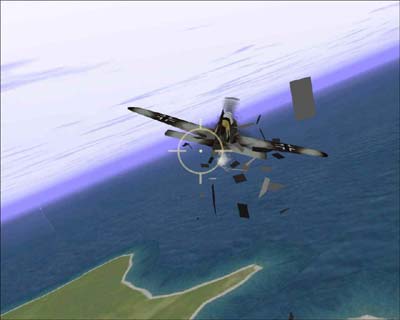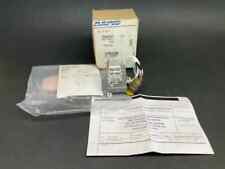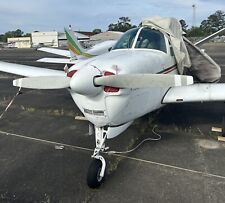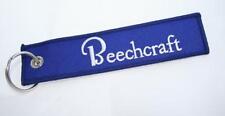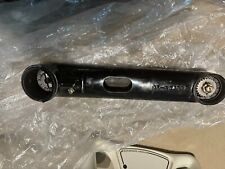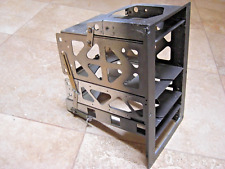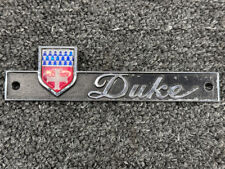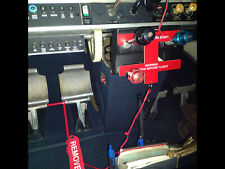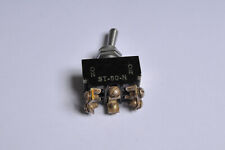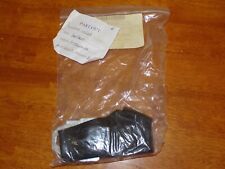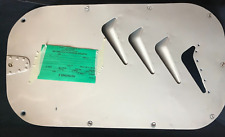Specific Examples of Rudder Use
Using Rudder To Improve Lookout
Let’s finish this rudder discussion by describing several ways in which the rudder can be used to our advantage in sim flying. The first is the use of rudder to improve our lookout ability, particularly to our six o’clock. Not every sim aircraft has a F-16 like unimpeded view to the rear. Some can be pretty blind in that area and checking for bandits at our rear can be a challenge. Rudder can be a big help here. Just select your rear looking view and then push the rudder in on the side that you are looking. This will “boot” the tail sideways and give you a good look into an area that was previously blocked.
The Hammerhead Maneuver.
A second specific use of rudder is in performing a maneuver known as a “hammerhead turn”. A hammerhead is a 180 degree reversal of course flown in a vertical climb. The objective is to climb vertically until your speed slows below stall speed. Then, the rudder is aggressively applied, usually with a corresponding application of power, to yaw the aircraft over and down into a diving attitude. This maneuver is tricky and requires immaculate timing but can be a big surprise when used to gain a role reversal against a pursuing and unsuspecting bandit. Each sim and each aircraft will have its own unique hammerhead applicability depending on the programmed flight model. You won’t be able to perform this maneuver in every sim, and as a rule, the maneuver is flown more easily in a prop aircraft where engine propwash can help provide the force needed to allow the rudder to yaw the aircraft sufficiently to get it to “swap ends”.
Let’s put aside the question of whether or not the hammerhead is tactically sound and just deal with the mechanics of how it is flown.
First, the usual statement that what applies to real life may or may not apply to a sim…it all depends on how “realistically” the sim flight model is programmed.
Putting that aside also, now let’s consider what is going on when we try to fly this maneuver. The hammerhead is not your “normal” aerobatic maneuver in the sense that you can just point the aircraft where you want it and expect everything to work out more or less as expected. This is especially true of prop driven aircraft.
In a prop aircraft, two forces are acting on the aircraft and must be accounted for. One is engine gyroscopic precession. The second is the effect of the prop driven airflow (“propwash”) on the aircraft itself. These two forces produce distinctly different results and depend on which way the prop rotates. When you choose which fighter you want to fly, make sure you note which way the prop rotates. Most US, Brit, and German engines rotate clockwise.
Let’s take propwash first. A clockwise rotating engine will produce a propwash that will try to push (yaw) the nose LEFT. This is a main reason why we need right rudder when taking off. It will be much easier to yaw the plane left than to the right for a clockwise rotating engine.
Now, gyro precession. This effect produces a pitch movement when yaw is applied to the aircraft. For a clockwise rotating engine, left yaw cause the nose to pitch UP…right yaw causes the aircraft to pitch down.
One more thing happens in a hammerhead that is not usually seen in other maneuvers…the wings produce different amounts of lift. In a hammerhead, one wing is going “down”, and the other is going “up”. The “up” going wing produces more lift than the other wing. This creates a tendency to roll and must be corrected for in the hammerhead to keep the plane from rolling over on to its “back”.
All right! Back to the maneuver! Tactically, I suggest that you not pull the power off when starting the climb. The idea here is to gain or maintain vertical separation on the bandit chasing you. Pulling the power off is contrary to maintaining this separation.
Next, you want to fly a vertical flight path. To do this, once you have the nose pointed straight up, you are going to have to unload your G to zero…otherwise you will pitch over on your back. Holding G in our sims is hard since we can’t “feel” the seat pressures. Sometimes an external or side snap view that allows you to see the horizon helps you maintain your vertical attitude. Either that, or set the time at 12:00 noon and fly at the sun!
Then fly that attitude until below 100mph…that’s just technique and will keep you from beginning the maneuver too soon.
Now you are ready to begin the maneuver. The hammerhead is flown as a three part maneuver. Step one, then step two, then step three. NOT a simultaneous maneuver!
Step one is to use rudder to yaw the aircraft in the desired direction. Which direction? The one that your engine rotation propwash makes easiest…for most planes, LEFT! How much rudder? All of it. How do you put the rudder in? Smoothly and quickly…BUT DO NOT “KICK” THE RUDDER PEDAL!!! This is a common expression and is pure BS…there is no maneuver flown where the pilot “kicks” anything! Push the rudder completely forward to the stop aggressively. This should start the aircraft into a yawing motion.
Step two is to use aileron to counter the tendency of the “up” wing to try to roll you over on your back. How much aileron to use? As much as necessary. How should you put it in? Smoothly and aggressively, but do not slam the stick sideways!
Step three is to use pitch (stick pressure) to offset gyroscopic precession. Which way do you move the stick? Depends on engine rotation direction! Let’s stick with our clockwise rotating engine! Forward (nose down) for a left hammerhead…backstick (nose up) for a right hammerhead.
- OK. Here it is for a clockwise rotating engine and a left hammerhead:
- Push and hold full left rudder.
- Push and hold right aileron as needed to keep from rolling.
- Then a little bit of forward stick as needed to prevent any pitching movement.
Hold these controls in until you approach about 45 degrees from straight down. Then smoothly reverse the rudder completely…in a left hammerhead, you now want to go full right rudder to stop the yaw as you reach a vertical attitude. Once the rudder is reversed, then neutralize your pitch input as you also neutralize your aileron.
One last word on flying the hammerhead. The technique above is real world oriented. Your sim may or may not fly real world. In the hammerhead, you may find that the aileron and pitch steps are not needed. No problem. The rudder may be the only control you need to fly this maneuver!









